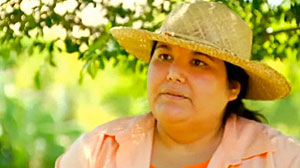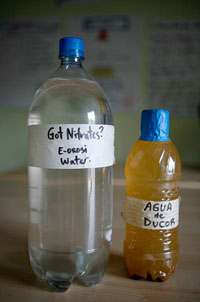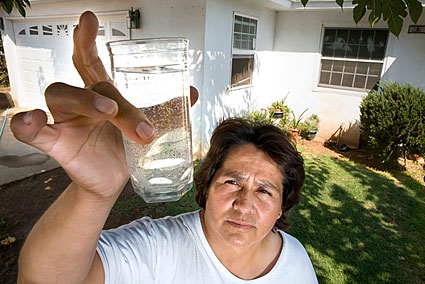
Eunice Martinez, Tooleville, Calif., resident. (Image from "Tapped the Movie," bonus clip "Farming and Water.")
Picture a hot summer day in California farm country, say 112 degrees. In the tiny community of Tooleville, surrounded by olive trees and orange groves, there’s one thing you won’t see here that you’d see almost anywhere else in the sunny state — kids splashing in backyard pools.
“People don’t let their kids swim in pools here,” says resident Eunice Martinez. “They’re scared of what would happen if they accidentally swallow the water.”
Martinez, 44, and the other 350 people who live in Tooleville haven’t been able to drink their tap water since 2003, due to unsafe levels of nitrate contamination.
Nitrate — a compound of nitrogen and oxygen — is the most common chemical contaminant in groundwater. That isn’t surprising when you consider its many sources: sewage overflows, fertilizer runoff, animal waste, and decaying organic material in soil. Nitrate is also found in foods, notably processed, preserved meats like bacon and naturally in green, leafy vegetables like spinach and celery. The list of health afflictions possibly linked to nitrate overexposure includes infant death, miscarriage, birth defects, diabetes, thyroid disease, and cancer.
Martinez says she and her neighbors stopped drinking the water before any acute health troubles hit, but she still worries. “There are many times when I’m in the shower and I’m thinking, ‘Am I going to get sick 10, 20 years from now?'” she says. “You know, with cancer, sometimes it takes years.”

The clear water from East Orosi, Calif., is more contaminated than the murky water on the right from Ducor. (Photo by Erin Lubin; courtesy of the Community Water Center.)
Feeling unwell
Once ingested, nitrate reacts with digestive bacteria to form nitrite. Nitrite changes hemoglobin, the oxygen-carrying protein in the blood, into methemoglobin, which can’t carry oxygen. In infants, whose bodies convert nitrate to nitrite more readily, this can cause methemoglobinemia or “blue-baby syndrome,” in which a child turns blue from the lack of oxygen and can die.
Nitrites can also react with other chemicals in the body to form what’s known as N-nitroso compounds, linked in animal studies to birth defects and cancer.
The scientific evidence linking environmental nitrate exposure to health problems is still murky. “There’s some smoke,” says Alan Townsend, assistant professor of ecology at the University of Colorado, Boulder. “How big the fire is, I don’t know. But there’s something there.”
Between 10 and 20 percent of groundwater sources exceed the federal Maximum Contaminant Level (MCL) of 10 parts per million for nitrate, Townsend says. The Safe Drinking Water Act requires public water supplies to test for nitrates and take action if they exceed the MCL. But small, private wells often aren’t regulated. The Environmental Protection Agency estimates that 16 percent of Americans get their drinking water from wells that are vulnerable to nitrate contamination.
Jean Brender, a professor in the School of Rural Public Health at Texas A&M, explains that the MCL for nitrate was set specifically to prevent blue baby syndrome. If an infant drinks formula mixed with highly contaminated water, symptoms can strike within days.
But she adds that research points to other potential health problems with chronic exposure to nitrates in drinking water, some at levels lower than the current MCL.
“Three studies have found an association between nitrate exposure during pregnancy and neural-tube defects such as spina bifida and anencephaly in newborns,” she says. “Two of those studies found that association with a contamination level lower than 10.”
Studies of cancer — particularly colon, rectal, kidney, or bladder cancer and non-Hodgkin’s lymphoma — have been inconsistent. In colon and kidney cancer, Brender says, the nitrate connection was only found in people with a vitamin C deficiency.
“So the joke around our office is that if you’re going to have a slice of bacon, have a glass of orange juice with it,” she says.
Even blue-baby syndrome cannot be blamed on nitrates alone, says James VanDerslice, who studied rural water quality for nine years with the Washington State Department of Health and currently teaches public health at the University of Utah.
“There are so many factors that come into play,” he says. “A baby may have diarrhea, which causes an upset that can increase nitrite levels. Nitrate can be in the food an infant eats. It can even be in medication for teething. It’s no one factor.”
Run-off problems

A Tulare County resident with some of the risky water. (Photo by Erin Lubin; courtesy of the Community Water Center.)
Nitrate contamination of water supplies is particularly common in agricultural areas, where mountains of livestock manure and synthetic nitrogen-based fertilizer seep through the soil into groundwater.
“Half of the fertilizer you’re putting on your crops never makes it to the plants you’re growing,” says Townsend. “It washes out.”
A study published last summer in the journal Southwest Hydrology estimated that California farmers applied 740,000 tons of nitrogen to 6.7 million acres of irrigated farmland in 2007. Of that, 110 pounds per acre aren’t used by the plants. Some escapes into the air, but an estimated 80 pounds of nitrogen (as nitrate) per acre per year seeps into the groundwater. (For more on how this happens, and what it means for the environment, see “The dark side of nitrogen.”)
Kathy Mathers, vice president of public affairs for The Fertilizer Institute, says her industry is willing to do its share to combat the problem. “We’re working with the farmers to make sure best practices are in place,” she says. “It’s a very site-specific practice. Crops need different levels of fertilizer, and soil can vary from county to county.”
Environmental advocates have argued that the MCL should be lowered to 5 ppm, and that water utilities should be given greater authority to stop polluters. But unless ongoing research provides stronger evidence of harm at lower levels, the MCL is unlikely to change. And for now, efforts to prevent contamination are more carrot than stick — pilot projects on farms and education programs about optimal fertilizer use.
Low-income Latino farmworkers are often the hardest hit by problems with contaminated drinking water, according to the Community Water Center, an advocacy group based in Visalia, California. Tulare County in the San Joaquin Valley, for example, where Tooleville is located, is one of the poorest counties in the state and also home to the highest number of violations. The center estimates that 20 percent of small public water systems in the county have unsafe levels of nitrates and other contaminants.
Horacio Amezquita manages a farmworkers’ housing cooperative outside Salinas, California. What started out as a ramshackle labor camp is now home to 64 families and a child care center. For five years, residents there couldn’t drink or cook with their tap water because of nitrate and trichloropropane contamination.
“When people showered with the water, they got rashes all over their skin,” Amezquita says. “Their eyes would get red, and their hair would fall out.”
After years of community activism, the county eventually authorized an emergency filtration plant for the contaminated wells in October of 2006. But like Martinez, Amezquita has unanswered questions about future risk.
“Some people have died of cancer,” he says. “We think it’s related to the water, but we can’t prove it. We don’t have the resources.”
Related:
Reporter Jason Margolis from Public Radio International interviews Eunice Martinez about Tooleville’s water situation:



